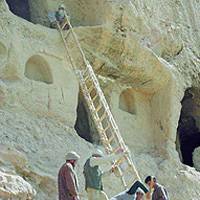Japanese experts have found a number of Buddhist scripture fragments dating from the seventh century in caves in Bamiyan, central Afghanistan, according to the National Research Institute for Cultural Properties.
The Tokyo-based institute said the Buddhist scriptures, written in Sanskrit, are the first to be discovered in the Bamiyan archaeological ruins since a French archaeologist found similar texts in 1930.
The institute examined nine groups of caves between mid-July and early August as part of a project aimed at preserving the ruins, which were damaged by the former Taliban regime.
The institute, commissioned to conduct research on the Bamiyan valley by UNESCO, discovered the scriptures near the threshold of caves located on the eastern side of the ruins.
The scriptures were written in black Sanskrit letters, it said, adding that the letters on the largest scripture, measuring 5 cm × 2 cm, were written on birch bark.
The handwriting style apparently dates back to the seventh century, the experts said, adding that the scriptures are believed to be philosophical Buddhist texts rather than Buddhist sutras.
As scholars have not investigated the caves thoroughly in recent times, there is a good chance of finding more treasures in the future, the institute said.
The experts also surveyed and collected some wall paintings from the caves, located about 240 km northwest of Kabul. Many of these had been damaged severely by the Taliban or by natural phenomena.
The institute will dispatch a group of researchers to the site in October to collect more wall paintings.
The complex is believed to have been built between the sixth and the ninth centuries.




